Disagreements in Equivalent-Factor-Based Valuation of County-Level Ecosystem Services in China: Insights from Comparison Among Ten LULC Datasets
Abstract
1. Introduction
2. Materials
2.1. Study Area and Evaluation Units of ESV
2.2. Data Sources and Preprocessing
2.2.1. Land Cover Data
2.2.2. Data Processing
3. Methods
3.1. ESV Evaluation Method
3.1.1. Calculation of the Standard Equivalent Factor
3.1.2. Evaluation of ESV
3.2. Disagreement Measurement of ESV Evaluation
3.2.1. Coefficient of Variation: Measuring ESV Disagreement for Each County
3.2.2. Confidence Interval: Range Estimation of ESV Based on Multiple Land Cover Data
3.3. Measurement of Dataset Applicability
3.3.1. Mean Z-Score
3.3.2. Minimum Error Frequency
4. Results and Analysis
4.1. Spatial Distribution of ESV Across Different Counties in China
4.1.1. Distribution of County-Level ESV Estimated Based on Different Datasets
4.1.2. Reference Values and Confidence Intervals of County-Level ESV
4.2. Spatial Distribution of Disagreement in ESV Evaluations
4.3. Applicability of the Land Cover Dataset in ESV Evaluation
5. Discussion
5.1. Comparison with Existing Studies
5.2. Practical Suitability of Land Cover Datasets for ESV Evaluation
5.2.1. Nationwide Applicability of Land Cover Datasets for ESV Evaluation
5.2.2. Regional Suitability Within Specific Ecological Function Zones
5.3. Explanation of ESV Disagreement
5.3.1. Effects of Landscape Pattern Disagreement on ESV Evaluation
5.3.2. Effects of Area Disagreement in Land Cover Types on the Inconsistency of ESV Evaluations
6. Conclusions
6.1. Findings and Conclusions
6.2. Limitations
Supplementary Materials
Author Contributions
Funding
Data Availability Statement
Acknowledgments
Conflicts of Interest
References
- Broekx, S.; Liekens, I.; Peelaerts, W.; De Nocker, L.; Landuyt, D.; Staes, J.; Meire, P.; Schaafsma, M.; Van Reeth, W.; Van den Kerckhove, O.; et al. A web application to support the quantification and valuation of ecosystem services. Environ. Impact Assess. Rev. 2013, 40, 65–74. [Google Scholar] [CrossRef]
- Baker, J.; Sheate, W.R.; Phillips, P.; Eales, R. Ecosystem services in environmental assessment—Help or hindrance? Environ. Impact Assess. Rev. 2013, 40, 3–13. [Google Scholar] [CrossRef]
- Schmidt, S.; Manceur, A.M.; Seppelt, R. Uncertainty of Monetary Valued Ecosystem Services—Value Transfer Functions for Global Mapping. PLoS ONE 2016, 11, e0148524. [Google Scholar] [CrossRef]
- Costanza, R. Misconceptions about the valuation of ecosystem services. Ecosyst. Serv. 2024, 70, 101667. [Google Scholar] [CrossRef]
- Zhang, Y.; Zheng, M.; Qin, B. Optimization of spatial layout based on ESV-FLUS model from the perspective of Production-Living-Ecological a case study of Wuhan City. Ecol. Model. 2023, 481, 110356. [Google Scholar] [CrossRef]
- Chen, Q. Temporal and Spatial Changes of Land Use and Ecosystem Service Value in Wuhan City from 2000 to 2020. Technol. Econ. Chang. 2022, 6, 16–21. [Google Scholar] [CrossRef]
- Fu, B.-J.; Su, C.-H.; Wei, Y.-P.; Willett, I.R.; Lü, Y.-H.; Liu, G.-H. Double counting in ecosystem services valuation: Causes and countermeasures. Ecol. Res. 2011, 26, 1–14. [Google Scholar] [CrossRef]
- Jacobs, S.; Dendoncker, N.; Martín-López, B.; Barton, D.N.; Gomez-Baggethun, E.; Boeraeve, F.; McGrath, F.L.; Vierikko, K.; Geneletti, D.; Katharina, J.S.; et al. A new valuation school: Integrating diverse values of nature in resource and land use decisions. Ecosyst. Serv. 2016, 22, 213–220. [Google Scholar] [CrossRef]
- De Groot, R.; Fisher, B.; Christie, M.; Aronson, J.; Braat, L.; Gowdy, J.; Haines-Young, R.; Maltby, E.; Neuville, A.; Polasky, S.; et al. Integrating the ecological and economic dimensions in biodiversity and ecosystem service valuation. In The Economics of Ecosystems and Biodiversity; Taylor and Francis: London, UK, 2012; pp. 9–40. [Google Scholar]
- Costanza, R.; d’Arge, R.; de Groot, R.; Farber, S.; Grasso, M.; Hannon, B.; Limburg, K.; Naeem, S.; O’Neill, R.V.; Paruelo, J.; et al. The value of the world’s ecosystem services and natural capital. Ecol. Econ. 1998, 25, 3–15. [Google Scholar] [CrossRef]
- Kumar, P.; Esen, S.E.; Yashiro, M. Linking ecosystem services to strategic environmental assessment in development policies. Environ. Impact Assess. Rev. 2013, 40, 75–81. [Google Scholar] [CrossRef]
- de Groot, R.; Brander, L.; van der Ploeg, S.; Costanza, R.; Bernard, F.; Braat, L.; Christie, M.; Crossman, N.; Ghermandi, A.; Hein, L.; et al. Global estimates of the value of ecosystems and their services in monetary units. Ecosyst. Serv. 2012, 1, 50–61. [Google Scholar] [CrossRef]
- Davidson, N.C.; van Dam, A.A.; Finlayson, C.M.; McInnes, R.J. Worth of wetlands: Revised global monetary values of coastal and inland wetland ecosystem services. Mar. Freshw. Res. 2019, 70, 1189–1194. [Google Scholar] [CrossRef]
- Jiang, W. Mapping ecosystem service value in Germany. Int. J. Sustain. Dev. World Ecol. 2018, 25, 518–534. [Google Scholar] [CrossRef]
- Anderson, S.J.; Ankor, B.L.; Sutton, P.C. Ecosystem service valuations of South Africa using a variety of land cover data sources and resolutions. Ecosyst. Serv. 2017, 27, 173–178. [Google Scholar] [CrossRef]
- Niquisse, S.; Cabral, P. Assessment of changes in ecosystem service monetary values in Mozambique. Environ. Dev. 2018, 25, 12–22. [Google Scholar] [CrossRef]
- Periotto, N.; Tundisi, J. A characterization of ecosystem services, drivers and values of two watersheds in São Paulo State, Brazil. Braz. J. Biol. 2017, 78, 397–407. [Google Scholar] [CrossRef] [PubMed]
- Xie, G.; Zhen, L.; Lu, C.; Xia, Y.; Chen, C. Expert Knowledge Based Valuation Method of Ecosystem Services in China. J. Nat. Resour. 2008, 23, 911–919. [Google Scholar]
- Xie, G.; Lu, C.; Leng, Y.; Zhen, D.; Li, S. Ecological assets valuation of the Tibetan Plateau. J. Nat. Resour. 2003, 18, 189–196. [Google Scholar]
- Zhang, B.; Li, W.; Xie, G. Ecosystem services research in China: Progress and perspective. Ecol. Econ. 2010, 69, 1389–1395. [Google Scholar] [CrossRef]
- Kang, N.; Hou, L.; Huang, J.; Liu, H. Ecosystem services valuation in China: A meta-analysis. Sci. Total Environ. 2022, 809, 151122. [Google Scholar] [CrossRef]
- Jiang, W.; Wu, T.; Fu, B. The value of ecosystem services in China: A systematic review for twenty years. Ecosyst. Serv. 2021, 52, 101365. [Google Scholar] [CrossRef]
- Liu, S.; Costanza, R.; Farber, S.; Troy, A. Valuing ecosystem services: Theory, practice, and the need for a transdisciplinary synthesis. Ann. N. Y. Acad. Sci. 2010, 1185, 54–78. [Google Scholar] [CrossRef]
- Zhang, C.; Li, X. Land Use and Land Cover Mapping in the Era of Big Data. Land 2022, 11, 1692. [Google Scholar] [CrossRef]
- Karra, K.; Kontgis, C.; Statman-Weil, Z.; Mazzariello, J.C.; Mathis, M.; Brumby, S.P. Global land use/land cover with Sentinel 2 and deep learning. In Proceedings of the 2021 IEEE International Geoscience and Remote Sensing Symposium IGARSS, Brussels, Belgium, 11–16 July 2021; pp. 4704–4707. [Google Scholar]
- Buchhorn, M.; Lesiv, M.; Tsendbazar, N.-E.; Herold, M.; Bertels, L.; Smets, B. Copernicus Global Land Cover Layers—Collection 2. Remote Sens. 2020, 12, 1044. [Google Scholar] [CrossRef]
- Bicheron, P.; Amberg, V.; Bourg, L.; Petit, D.; Huc, M.; Miras, B.; Brockmann, C.; Hagolle, O.; Delwart, S.; Ranera, F.; et al. Geolocation Assessment of MERIS GlobCover Orthorectified Products. IEEE Trans. Geosci. Remote Sens. 2011, 49, 2972–2982. [Google Scholar] [CrossRef]
- ESA. Land Cover CCI. Product User Guide Version 2.0; UCL-Geomatics: London, UK, 2017. [Google Scholar]
- Gong, P.; Liu, H.; Zhang, M.; Li, C.; Wang, J.; Huang, H.; Clinton, N.; Ji, L.; Li, W.; Bai, Y.; et al. Stable classification with limited sample: Transferring a 30-m resolution sample set collected in 2015 to mapping 10-m resolution global land cover in 2017. Sci. Bull. 2019, 64, 370–373. [Google Scholar] [CrossRef] [PubMed]
- Yang, J.; Huang, X. The 30m annual land cover dataset and its dynamics in China from 1990 to 2019. Earth Syst. Sci. Data 2021, 13, 3907–3925. [Google Scholar] [CrossRef]
- Chen, J.; Chen, J.; Liao, A.; Cao, X.; Chen, L.; Chen, X.; He, C.; Han, G.; Peng, S.; Lu, M.; et al. Global land cover mapping at 30m resolution: A POK-based operational approach. J. Photogramm. Remote Sens. 2015, 103, 7–27. [Google Scholar] [CrossRef]
- Zhang, X.; Zhao, T.; Xu, H.; Liu, W.; Wang, J.; Chen, X.; Liu, L. GLC_FCS30D: The first global 30 m land-cover dynamics monitoring product with a fine classification system for the period from 1985 to 2022 generated using dense-time-series Landsat imagery and the continuous change-detection method. Earth Syst. Sci. Data 2024, 16, 1353–1381. [Google Scholar] [CrossRef]
- Xu, X.; Liu, J.; Zhang, S.; Li, R.; Yan, C.; Wu, S. China’s multi-period land use land cover remote sensing monitoring data set (CNLUCC). [DB/OL]; Data Registration and Publishing System of the Resource and Environment Science Data Center of the Chinese Academy of Sciences: Beijing, China, 2018. [Google Scholar] [CrossRef]
- Liu, S.; Wang, H.; Hu, Y.; Zhang, M.; Zhu, Y.; Wang, Z.; Li, D.; Yang, M.; Wang, F. Land Use and Land Cover Mapping in China Using Multimodal Fine-Grained Dual Network. IEEE Trans. Geosci. Remote Sens. 2023, 61, 4405219. [Google Scholar] [CrossRef]
- Sulla-Menashe, D.; Gray, J.M.; Abercrombie, S.P.; Friedl, M.A. Hierarchical mapping of annual global land cover 2001 to present: The MODIS Collection 6 Land Cover product. Remote Sens. Environ. 2019, 222, 183–194. [Google Scholar] [CrossRef]
- Zanaga, D.; Kerchove, R.V.D.; Keersmaecker, W.d.; Souverijns, N.; Brockmann, C.; Quast, R.; Wevers, J.; Grosu, A.C.; Paccini, A.; Vergnaud, S.; et al. ESA WorldCover 10 m 2020 v100. 2021. Available online: https://pure.iiasa.ac.at/id/eprint/17832/ (accessed on 24 October 2023).
- Chakraborty, T.C.; Venter, Z.S.; Demuzere, M.; Zhan, W.; Gao, J.; Zhao, L.; Qian, Y. Large disagreements in estimates of urban land across scales and their implications. Nat. Commun. 2024, 15, 9165. [Google Scholar] [CrossRef] [PubMed]
- Congalton, R.G.; Gu, J.; Yadav, K.; Thenkabail, P.; Ozdogan, M. Global Land Cover Mapping: A Review and Uncertainty Analysis. Remote Sens. 2014, 6, 12070–12093. [Google Scholar] [CrossRef]
- Bai, Y.; Feng, M.; Jiang, H.; Wang, J.; Zhu, Y.; Liu, Y. Assessing Consistency of Five Global Land Cover Data Sets in China. Remote Sens. 2014, 6, 8739–8759. [Google Scholar] [CrossRef]
- Ji, X.; Han, X.; Zhu, X.; Huang, Y.; Song, Z.; Wang, J.; Zhou, M.; Wang, X. Comparison and Validation of Multiple Medium- and High-Resolution Land Cover Products in Southwest China. Remote Sens. 2024, 16, 1111. [Google Scholar] [CrossRef]
- Yang, Y.; Xiao, P.; Feng, X.; Li, H. Accuracy assessment of seven global land cover datasets over China. J. Photogramm. Remote Sens. 2017, 125, 156–173. [Google Scholar] [CrossRef]
- Fonte, C.C.; Duarte, D.; Jesus, I.; Costa, H.; Benevides, P.; Moreira, F.; Caetano, M. Accuracy Assessment and Comparison of National, European and Global Land Use Land Cover Maps at the National Scale—Case Study: Portugal. Remote Sens. 2024, 16, 1504. [Google Scholar] [CrossRef]
- Li, Z.; Chen, X.; Qi, J.; Xu, C.; An, J.; Chen, J. Accuracy assessment of land cover products in China from 2000 to 2020. Sci. Rep. 2023, 13, 12936. [Google Scholar] [CrossRef]
- Jiang, J.; Tian, G. Responses of Ecosystem Service Value to Land Use Change in Beijing from 1998 to 2005. Resour. Sci. 2010, 32, 1407–1416. [Google Scholar]
- Wang, J.; Hu, Y.; Lv, X.; Zheng, X. Study of Ecosystem Service Values Based on Land Use Change in Beijing. Chin. Agric. Sci. Bull. 2012, 28, 229–236. [Google Scholar]
- Li, F.; Zhang, B.; Zhang, S. Ecosystem Service Valuation of Sanjiang Plain. J. Arid. Land Resour. Environ. 2004, 18, 19–23. [Google Scholar]
- Wang, Z.; Zhang, S.; Zhang, B. Effects of land use change on values of ecosystem services of Sanjiang Plain, China. China Environ. Sci. 2004, 24, 125–128. [Google Scholar]
- Xing, L.; Hu, M.; Wang, Y. Integrating ecosystem services value and uncertainty into regional ecological risk assessment: A case study of Hubei Province, Central China. Sci. Total Environ. 2020, 740, 140126. [Google Scholar] [CrossRef] [PubMed]
- Schulp, C.J.E.; Burkhard, B.; Maes, J.; Van Vliet, J.; Verburg, P.H. Uncertainties in Ecosystem Service Maps: A Comparison on the European Scale. PLoS ONE 2014, 9, e109643. [Google Scholar] [CrossRef] [PubMed]
- Song, X.-P. Global Estimates of Ecosystem Service Value and Change: Taking Into Account Uncertainties in Satellite-based Land Cover Data. Ecol. Econ. 2018, 143, 227–235. [Google Scholar] [CrossRef]
- Zhang, L.; Yu, X.; Jiang, M.; Xue, Z.; Lu, X.; Zou, Y. A consistent ecosystem services valuation method based on Total Economic Value and Equivalent Value Factors: A case study in the Sanjiang Plain, Northeast China. Ecol. Complex. 2017, 29, 40–48. [Google Scholar] [CrossRef]
- Herold, M.; Mayaux, P.; Woodcock, C.E.; Baccini, A.; Schmullius, C. Some challenges in global land cover mapping: An assessment of agreement and accuracy in existing 1 km datasets. Remote Sens. Environ. 2008, 112, 2538–2556. [Google Scholar] [CrossRef]
- Ouyang, Z. Problems and changing Trends Faced by China’s ecosystem. China Sci. News 2017. [Google Scholar]
- Dai, Z.; Hu, Y.; Zhang, Q. Agreement Analysis of Multi-source Land Cover Products Derived from Remote Sensing in South America. Remote Sens. Inf. 2017, 32, 137–148. [Google Scholar]
- Xie, G.; Zhang, C.; Zhang, L.; Chen, W.; Li, S. Improvement of the Evaluation Method for Ecosystem Service Value Based on Per Unit Area. J. Nat. Resour. 2015, 30, 1243–1254. [Google Scholar]
- Venter, Z.S.; Barton, D.N.; Chakraborty, T.; Simensen, T.; Singh, G. Global 10 m Land Use Land Cover Datasets: A Comparison of Dynamic World, World Cover and Esri Land Cover. Remote Sens. 2022, 14, 4101. [Google Scholar] [CrossRef]
- Xu, P.; Tsendbazar, N.-E.; Herold, M.; de Bruin, S.; Koopmans, M.; Birch, T.; Carter, S.; Fritz, S.; Lesiv, M.; Mazur, E.; et al. Comparative validation of recent 10 m-resolution global land cover maps. Remote Sens. Environ. 2024, 311, 114316. [Google Scholar] [CrossRef]
- Gao, Y.; Liu, L.; Zhang, X.; Chen, X.; Mi, J.; Xie, S. Consistency Analysis and Accuracy Assessment of Three Global 30-m Land-Cover Products over the European Union using the LUCAS Dataset. Remote Sens. 2020, 12, 3479. [Google Scholar] [CrossRef]
- Xu, Y.; Yu, L.; Feng, D.; Peng, D.; Li, C.; Huang, X.; Lu, H.; Gong, P. Comparisons of three recent moderate resolution African land cover datasets: CGLS-LC100, ESA-S2-LC20, and FROM-GLC-Africa30. Int. J. Remote Sens. 2019, 40, 6185–6202. [Google Scholar] [CrossRef]
- Zhang, X.; Ren, W.; Peng, H. Urban land use change simulation and spatial responses of ecosystem service value under multiple scenarios: A case study of Wuhan, China. Ecol. Indic. 2022, 144, 109526. [Google Scholar] [CrossRef]
- Jiu, J. Study on the Implication of Land Use Change on Ecosystem Service Value in Hubei Province. Master’s Thesis, Huazhong University of Science and Technology, Wuhan, China, 2021. [Google Scholar]
- Chen, R.; Huang, C. Landscape Evolution and It’s Impact of Ecosystem Service Value of the Wuhan City, China. Int. J. Environ. Res. Public Health 2021, 18, 13015. [Google Scholar] [CrossRef]
- Xiong, X.; Zhou, T.; Cai, T.; Huang, W.; Li, J.; Cui, X.; Li, F. Land Use Transition and Effects on Ecosystem Services in Water-Rich Cities under Rapid Urbanization: A Case Study of Wuhan City, China. Land 2022, 11, 1153. [Google Scholar] [CrossRef]
- Cui, X.; Huang, L. Integrating ecosystem services and ecological risks for urban ecological zoning: A case study of Wuhan City, China. Hum. Ecol. Risk Assess. Int. J. 2023, 29, 1299–1317. [Google Scholar] [CrossRef]
- Feng, C. Research on Land Use Change and Eeological Risk in LanzhouCity Under Multi-Scenario Simulation. Master’s Thesis, Lanzhou Jiaotong University, Lanzhou, China, 2023. [Google Scholar]
- Zou, Y.; Liang, H.; Li, G. Evaluation of ecological carrying capacity and spatial planning strategy based on service function and sensitivity—Taking Lanzhou City as an example. For. Ecol. Sci. 2023, 38, 183–194+208. [Google Scholar] [CrossRef]
- Liu, J.; Xiao, B.; Jiao, J.; Li, Y.; Wang, X. Modeling the response of ecological service value to land use change through deep learning simulation in Lanzhou, China. Sci. Total Environ. 2021, 796, 148981. [Google Scholar] [CrossRef]
- Wei, Y.; Chen, Q. Study on the evolution of spatial pattern of “three lives” and the response of ecosystem service value: A case study of Hangzhou. In Proceedings of the 2020/2021 China Urban Planning Annual Conference and 2021 China Urban Planning Academic Season, Chengdu, China, 25–30 September 2021; p. 13. [Google Scholar]
- Kong, L.; Su, S. Spatiotemporal variation of ecosystem service value in Hangzhou based on land use. Environ. Pollut. Control 2022, 44, 1539–1545. [Google Scholar] [CrossRef]
- Li, L. Ecological Risk Assessment of Yangtze River Delta Urban Agglomeration Based on Ecosystem Service Value. Master’s Thesis, Shanghai Normal University, Shanghai, China, 2022. [Google Scholar]

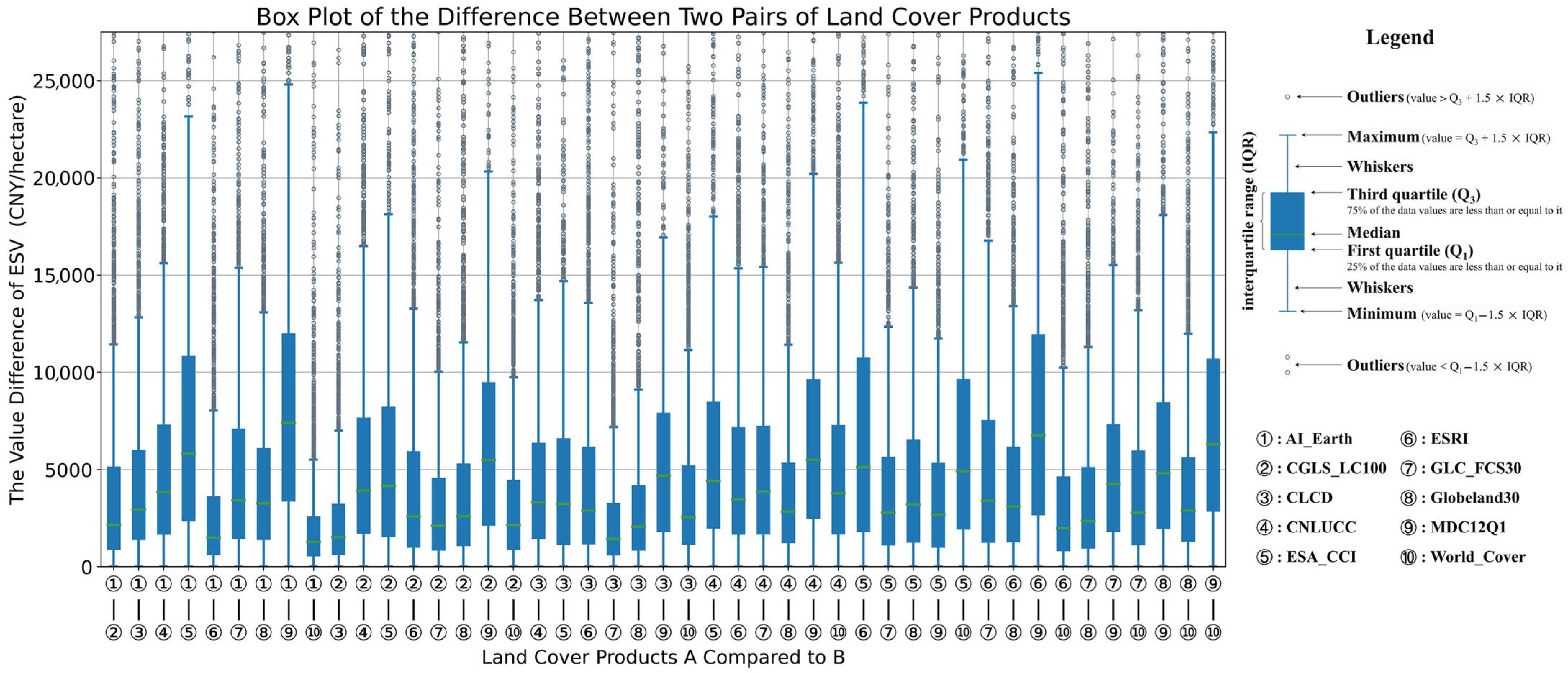
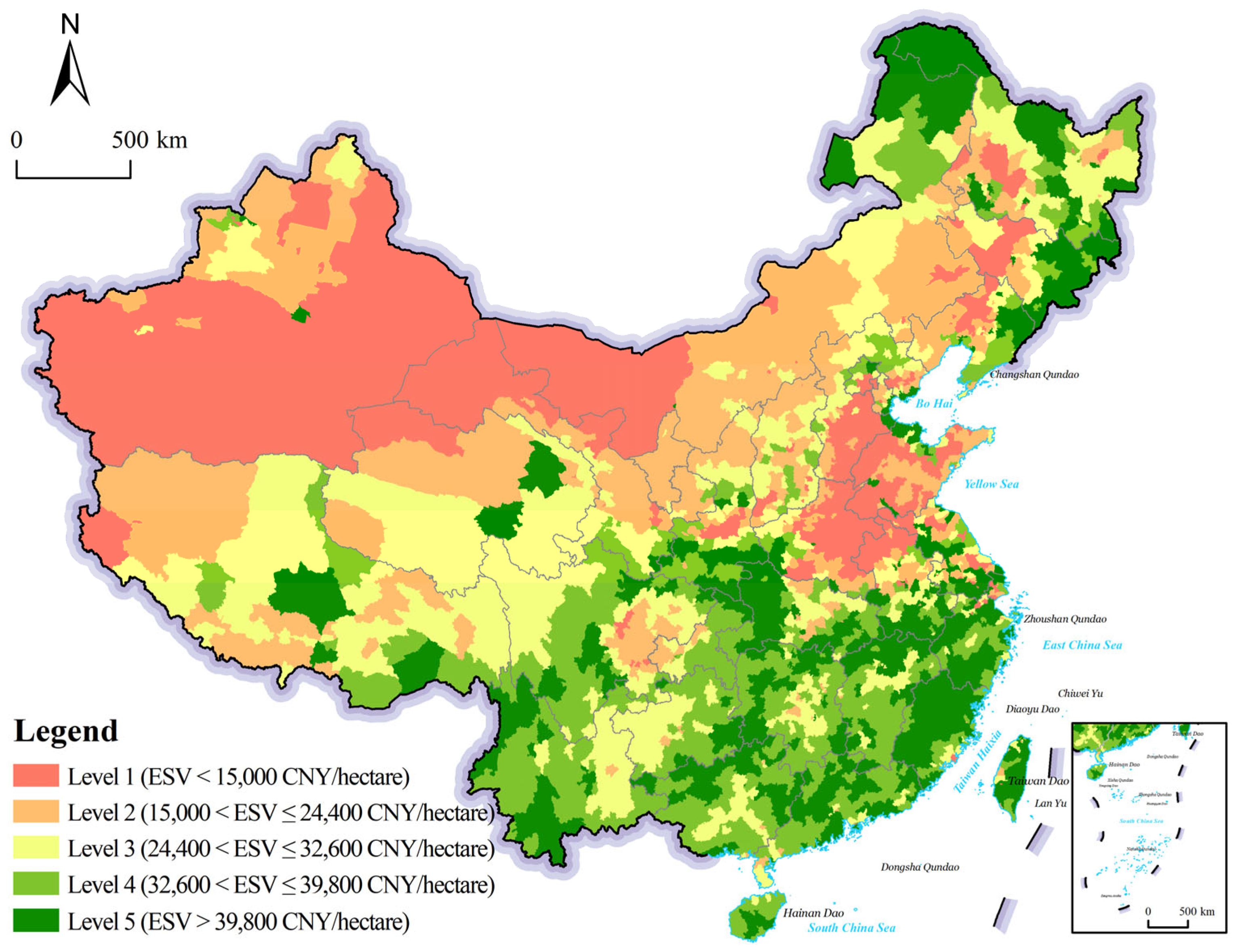
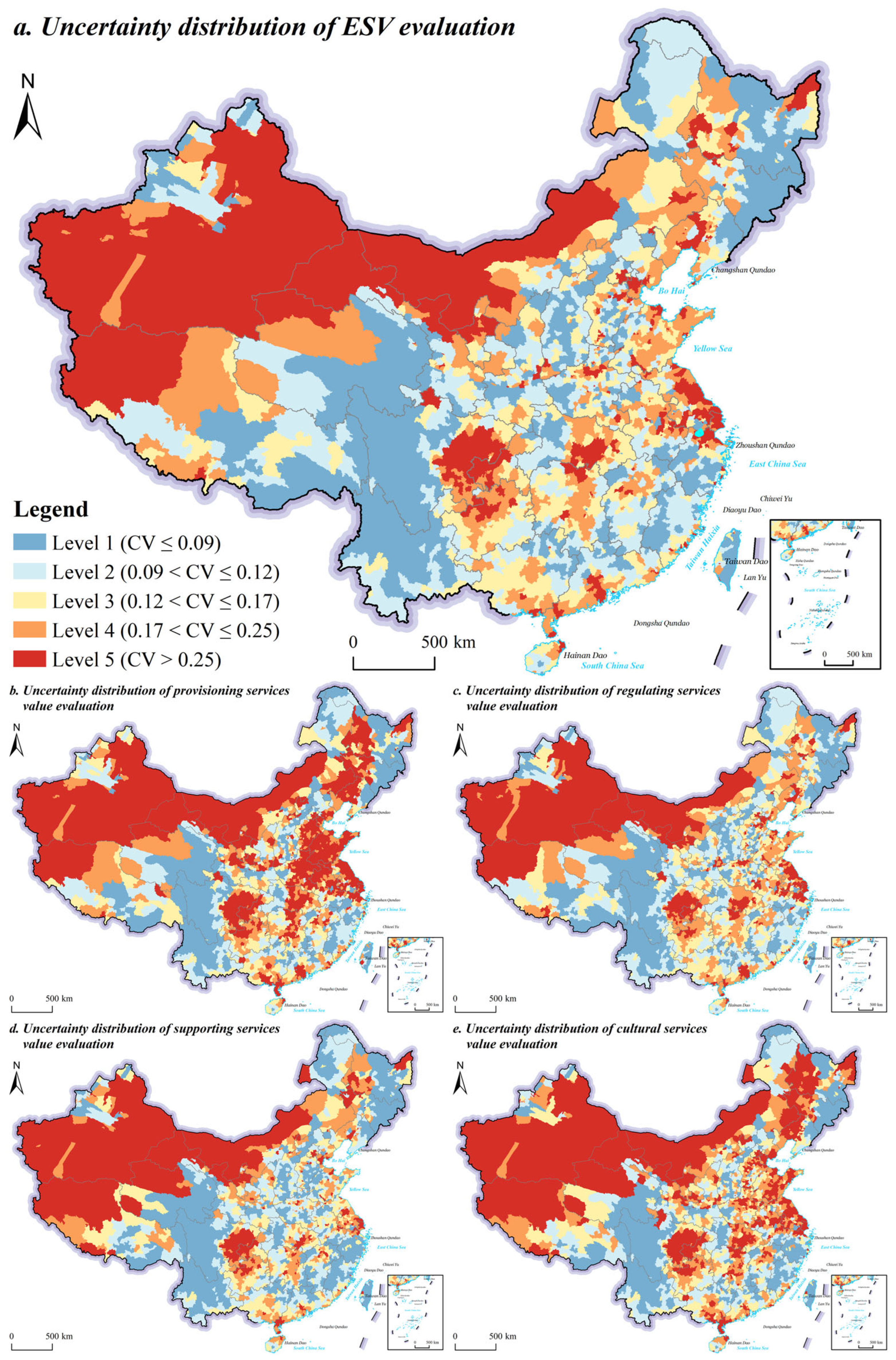
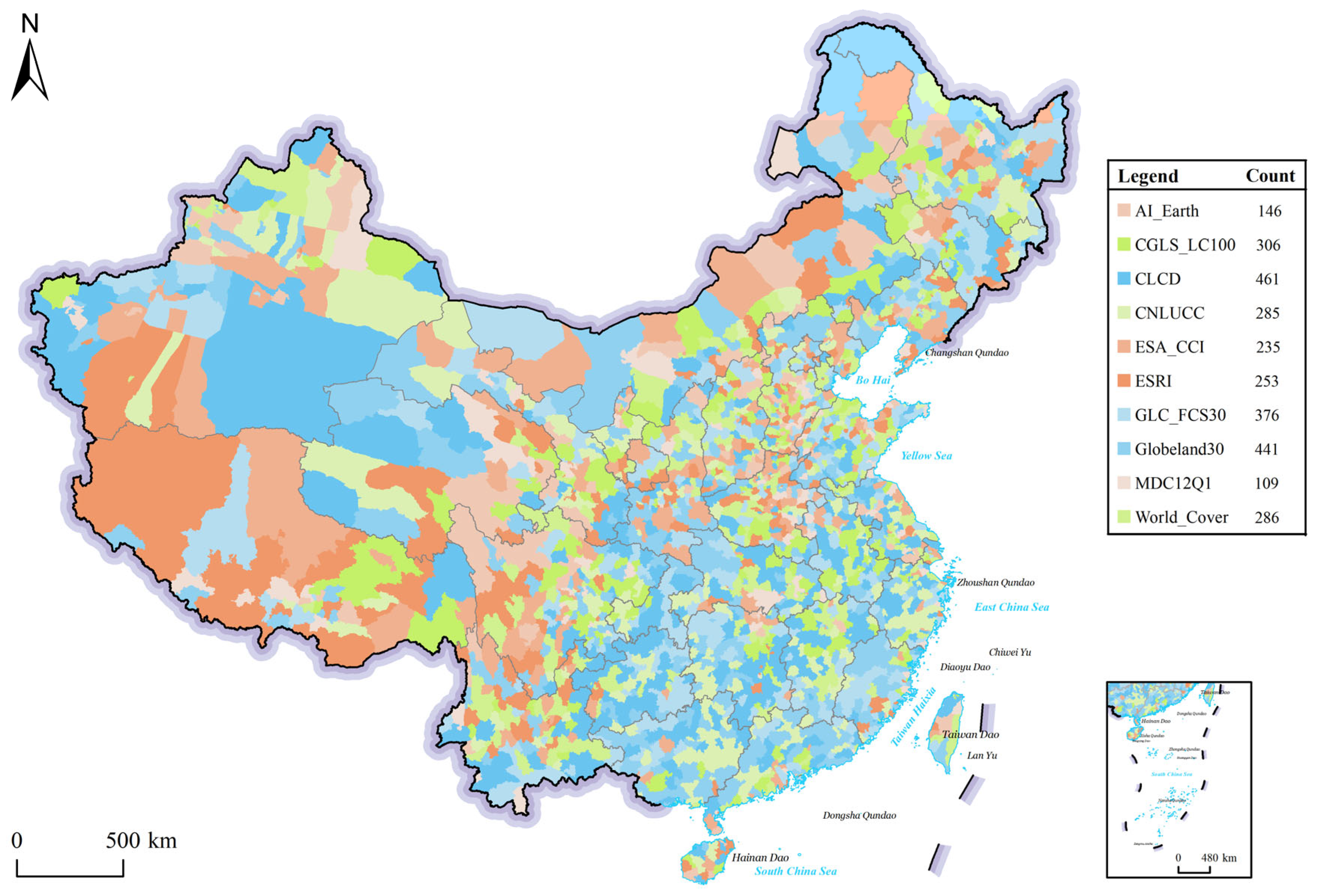


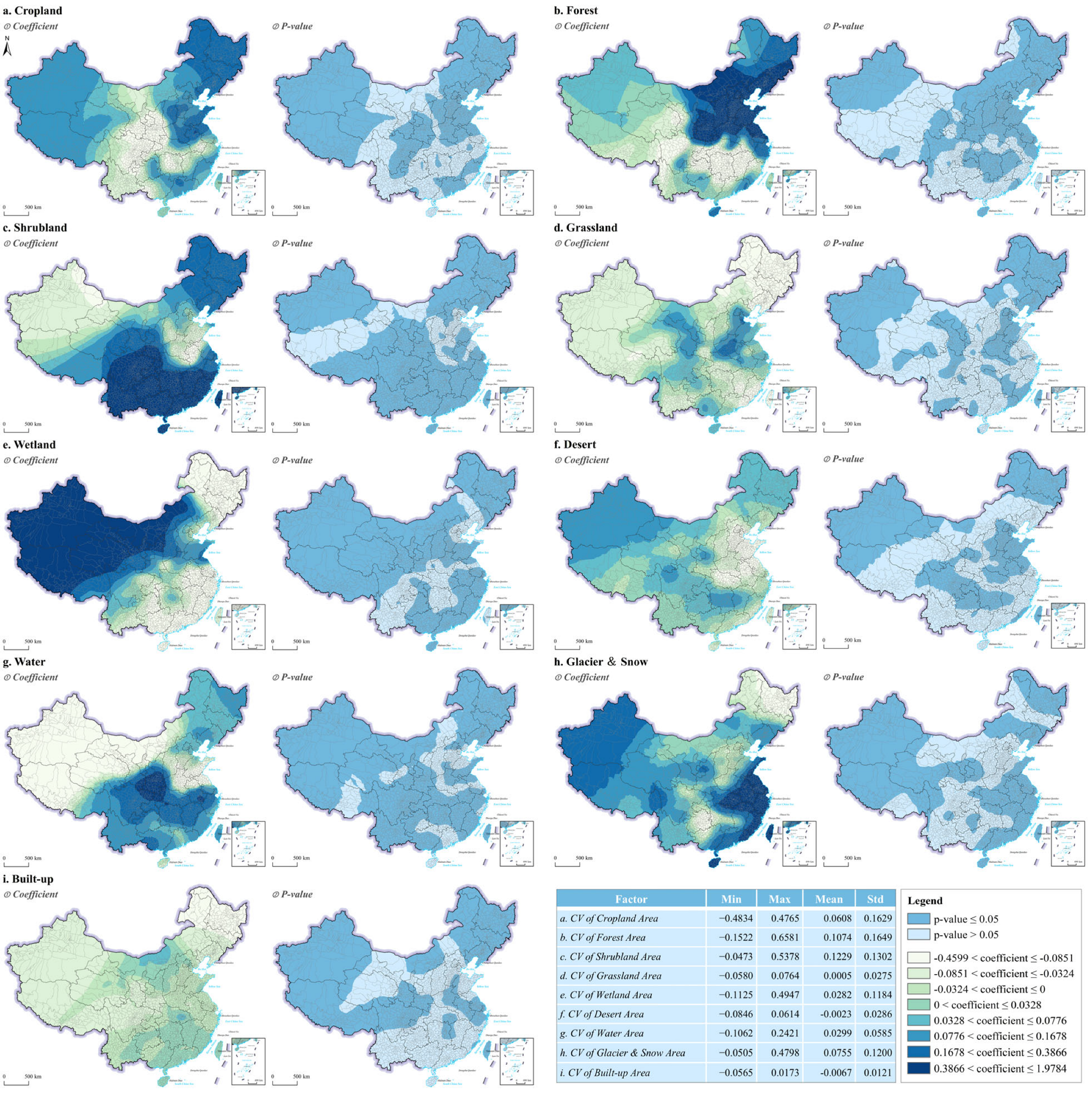
| Dataset | Mean Z-Score | Minimum Error Frequency | Dataset | Mean Z-Score | Minimum Error Frequency |
|---|---|---|---|---|---|
| AI Earth | 0.8 | 5.04% | ESRI | 0.8 | 8.73% |
| CGLS_LC100 | 0.67 | 10.56% | GLC_FCS30 | 0.56 | 12.97% |
| CLCD | 0.51 | 15.91% | Globeland30 | 0.58 | 15.22% |
| CNLUCC | 0.93 | 9.83% | MDC12Q1 | 1.23 | 3.76% |
| ESA_CCI | 0.89 | 8.11% | World Cover | 0.71 | 9.87% |
| Proportion | AI_Earth | CGLS_LC100 | CLCD | CNLUCC | ESA_CCI | ESRI | GLC_FCS30 | Globeland30 | MDC12Q1 | World_Cover |
|---|---|---|---|---|---|---|---|---|---|---|
| I-01 Water Conservation Functional Zone | 4.80% | 8.87% | 19.33% | 9.45% | 5.96% | 7.12% | 13.23% | 20.06% | 3.63% | 7.56% |
| I-02 Biodiversity Conservation Functional Zone | 4.22% | 6.17% | 19.16% | 11.36% | 12.99% | 10.06% | 9.74% | 15.26% | 0.65% | 10.39% |
| I-03 Soil Retention Functional Zone | 2.68% | 9.75% | 17.21% | 11.85% | 7.46% | 8.03% | 17.02% | 12.43% | 1.91% | 11.66% |
| I-04 Windbreak and Sand Stabilization Functional Zone | 10.53% | 11.28% | 14.29% | 9.77% | 9.77% | 8.27% | 10.53% | 13.53% | 4.51% | 7.52% |
| I-05 Flood Regulation Functional Zone | 11.36% | 6.82% | 6.82% | 11.36% | 18.18% | 2.27% | 9.09% | 11.36% | 6.82% | 15.91% |
| II-01 Agricultural Production Functional Zone | 5.99% | 13.65% | 13.17% | 8.98% | 8.38% | 9.82% | 9.70% | 14.49% | 5.75% | 10.06% |
| II-02 Forestry Production Functional Zone | 0.00% | 13.75% | 16.25% | 8.75% | 3.75% | 1.25% | 28.75% | 17.50% | 3.75% | 6.25% |
| III-01 Metropolitan Human Settlement Support Functional Zone | 2.94% | 7.84% | 15.69% | 6.86% | 8.82% | 8.82% | 16.67% | 13.73% | 1.96% | 16.67% |
| III-02 Key Urban Cluster Human Settlement Support Functional Zone | 6.34% | 9.86% | 7.75% | 9.86% | 7.04% | 17.61% | 14.79% | 10.56% | 5.63% | 10.56% |
| Variable | Unstandardized Coefficient (B) | Standardized Coefficient (Beta) | p | VIF |
|---|---|---|---|---|
| Constant | −0.372 | — | 0.000 | — |
| CV of Patch Density (PD_CV) | 0.07 | 0.14 | 0.000 | 2.264 |
| CV of Largest Patch Index (LPI_CV) | 0.055 | 0.057 | 0.000 | 1.051 |
| CV of Landscape Shape Index (LSI_CV) | 0.203 | 0.222 | 0.000 | 3.346 |
| CV of Area-Weighted Mean Shape Index (AWMSI_CV) | 0.28 | 0.276 | 0.000 | 2.175 |
| CV of Contagion (CONTAG_CV) | 0.862 | 0.378 | 0.000 | 1.200 |
| CV of Shannon’s Diversity Index (SHDI_CV) | −0.029 | −0.028 | 0.097 | 1.449 |
Disclaimer/Publisher’s Note: The statements, opinions and data contained in all publications are solely those of the individual author(s) and contributor(s) and not of MDPI and/or the editor(s). MDPI and/or the editor(s) disclaim responsibility for any injury to people or property resulting from any ideas, methods, instructions or products referred to in the content. |
© 2025 by the authors. Licensee MDPI, Basel, Switzerland. This article is an open access article distributed under the terms and conditions of the Creative Commons Attribution (CC BY) license (https://creativecommons.org/licenses/by/4.0/).
Share and Cite
Song, D.; Wang, L.; Wang, Y.; Zhao, B.; Jin, Q.; Yang, J. Disagreements in Equivalent-Factor-Based Valuation of County-Level Ecosystem Services in China: Insights from Comparison Among Ten LULC Datasets. Remote Sens. 2025, 17, 2320. https://doi.org/10.3390/rs17132320
Song D, Wang L, Wang Y, Zhao B, Jin Q, Yang J. Disagreements in Equivalent-Factor-Based Valuation of County-Level Ecosystem Services in China: Insights from Comparison Among Ten LULC Datasets. Remote Sensing. 2025; 17(13):2320. https://doi.org/10.3390/rs17132320
Chicago/Turabian StyleSong, Daiyi, Lizhou Wang, Yingge Wang, Bowen Zhao, Qi Jin, and Jianxin Yang. 2025. "Disagreements in Equivalent-Factor-Based Valuation of County-Level Ecosystem Services in China: Insights from Comparison Among Ten LULC Datasets" Remote Sensing 17, no. 13: 2320. https://doi.org/10.3390/rs17132320
APA StyleSong, D., Wang, L., Wang, Y., Zhao, B., Jin, Q., & Yang, J. (2025). Disagreements in Equivalent-Factor-Based Valuation of County-Level Ecosystem Services in China: Insights from Comparison Among Ten LULC Datasets. Remote Sensing, 17(13), 2320. https://doi.org/10.3390/rs17132320






